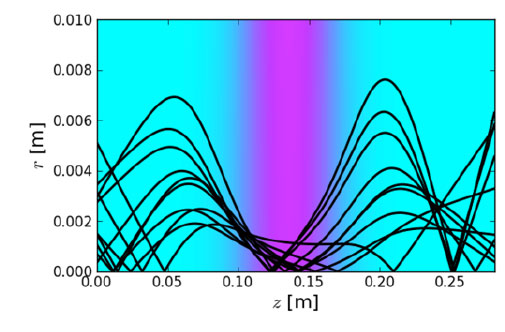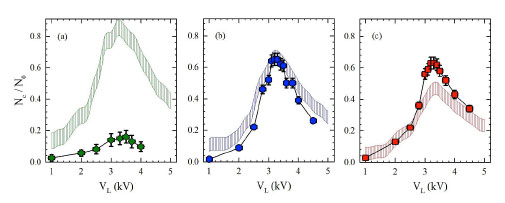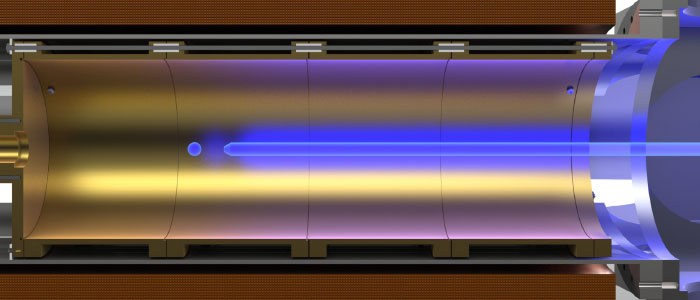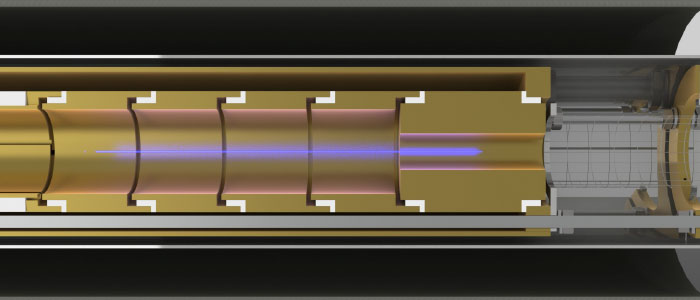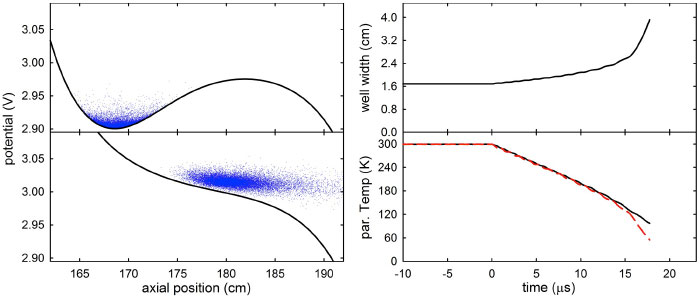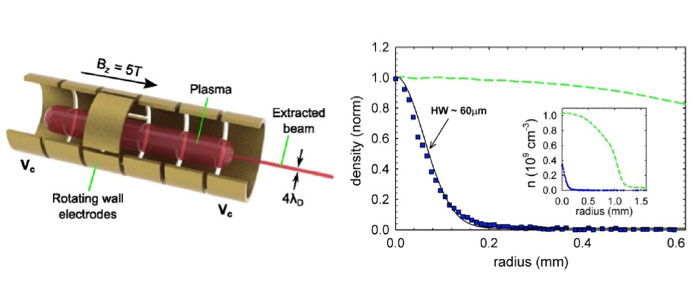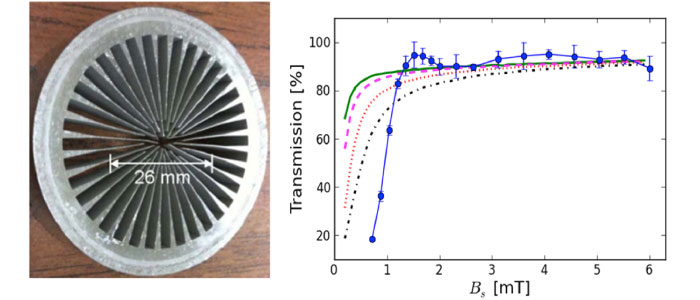Antimatter TechnologyBeams
Buffer-Gas Trap Beam
The buffer-gas trap (BGT) creates a pulsed positron beam with high energy and temporal resolution to be used for a variety of applications. The beam is tunable from 0.1 eV to keV energies, with energy resolutions as low as 35 meV FWHM. This state-of-the-art BGT beam, which was produced in our lab, represented the highest energy resolution positron beam produced at the time, but has since been surpassed by the cryogenic beam-tailoring trap (CBT) beam.
The buffer-gas trap (BGT) captures the steady-state moderated positron beam and re-emits it as a pulsed beam with high energy and temporal resolution.
The beam energy distribution can be separated into components both parallel and perpendicular to the magnetic field. The parallel energy distribution is approximately Gaussian in shape, with an energy spread as low as 18 meV full-width at half-max (FWHM). Since the positrons are cooled to room temperature before ejection (~300K), the perpendicular energy distribution is a Maxwell-Boltzmann with a standard deviation of 26 meV. The total energy distribution takes the form of an exponentially-modified Gaussian (EMG) distribution with a spread as low as 35 meV FWHM.
The temporal and radial distributions of the BGT beam are both approximately Gaussian in shape. While the temporal resolution varies with the chosen ejection protocol, under typical conditions the temporal spread is approximately 2 µs FWHM. The radial distribution has a typical spread of approximately 1.5 cm FWHM in the trap.
The BGT-based beam is used for a variety of applications including atomic and molecular scattering, positron binding to molecules, annihilation processes, material science and antihydrogen and positronium formation. More recently, the BGT beam is used as input to the cryogenic beam-tailoring trap (CBT), which further improves the beam characteristics.
Further Reading:
Formation mechanisms and optimization of trap-based positron beams, M. R. Natisin, J. R. Danielson, and C. M. Surko, Phys. Plasmas 23, 023505 (2016).
Formation of buffer-gas-trap based positron beams, M. Natisin et. al., Phys. Plasmas 22, 033501 (2015)
Creation of a monoenergetic pulsed positron beam, S. Gilbert et. al., Appl. Phys. Lett. 70 1944 (1997)
New Source of Ultra-cold Positron and Electron Beams, C. Kurz, S. J. Gilbert, R. G. Greaves and C. M. Surko, J. Nuclear Instruments and Methods B, 143, pp. 188-94 (1998).
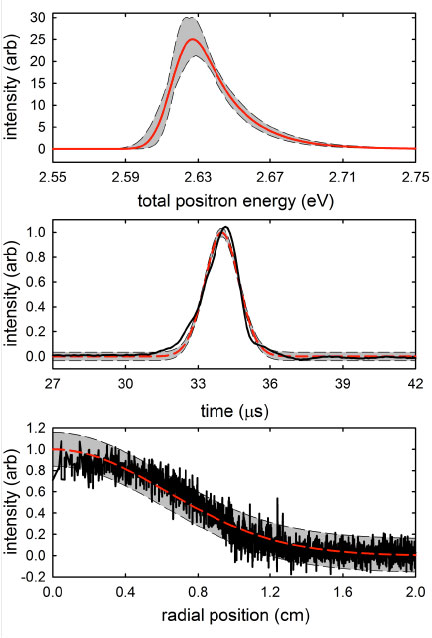
Cryogenic Beam-Tailoring Trap Beam
The beam generated by the cryogenic beam-tailoring trap (CBT) has superior energy resolution compared with any positron beam previously produced. The total energy spread is as low as 6.9 meV FWHM, which is a factor of five better than the previous state-of-the-art. In addition, it has sub-microsecond temporal resolution and millimeter spatial resolution. These characteristics enable the study of a variety of new processes.
The cryogenic Beam-Tailoring Trap (CBT) re-traps the beam generated by the buffer-gas trap (BGT) and re-emits it as a pulsed cryogenic positron beam with superior characteristics.
The beam energy distribution can be separated into components both parallel and perpendicular to the magnetic field. The parallel energy distribution is approximately Gaussian in shape, with an energy spread as low as 4.0 meV full width at half max (FWHM), which is approximately five times better than the previous state of the art BGT beam. Since the positrons are cooled to 50K before ejection, the perpendicular energy distribution is a Maxwell-Boltzmann with a standard deviation of 4.5 meV, which is a factor of six better than previously obtained. The total energy distribution takes the form of an exponentially-modified Gaussian (EMG) distribution with a spread as low as 6.9 meV FWHM, which results in approximately five times better energy resolution than the previous state-of-the-art positron beam.
In addition to having significantly improved energy resolution, the CBT beam also maintains excellent temporal and spatial resolution. Both the temporal and radial distributions are approximately Gaussian in shape, with spreads of approximately 0.5 µs FWHM and 1 mm FWHM, respectively.
The ultra-high energy resolution of the CBT beam enables the study of a variety of new processes which were difficult or impossible to study previously. For example, this resolution will allow a more detailed study of positron induced intramolecular vibrational redistribution (IVR), and is sufficient to make the first state-resolved measurements of rotational excitation and vibrational multimode excitation.
Further Reading:
An Ultra-High Energy Resolution Cryogenic Trap-Based Positron Beam, M. R. Natisin et. al., Appl. Phys. Lett. 108, 024102 (2016).
Formation mechanisms and optimization of trap-based positron beams, M. R. Natisin, J. R. Danielson, and C. M. Surko, Phys. Plasmas 23, 023505 (2016).
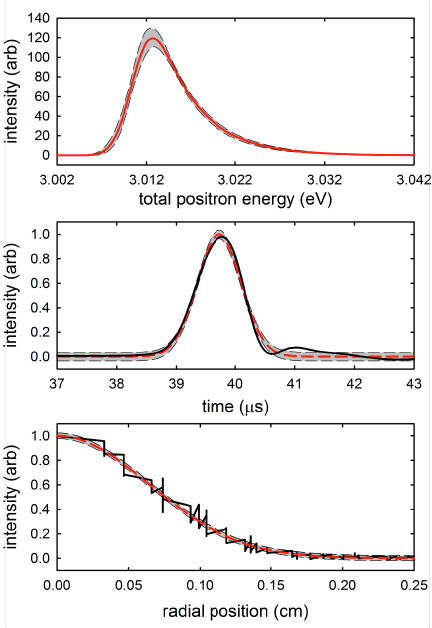
Simulations and Optimization
While trap-based positron beams have been used since the late 1990’s, the processes underlying their formation have only recently been studied in detail. Monte-Carlo simulations of beam-formation have shown it to be intrinsically dynamic, with the particle dynamics just before ejection primarily responsible for the resulting beam quality. These studies are then used as a guide for the optimization of next-generation, high energy resolution, positron beams.
Trap-based positron beams, such as those created from the buffer gas trap and cryogenic beam-tailoring trap, are now used for a wide variety of scientific applications. Under typical conditions, a trapped and thermalized cloud of positrons are ejected from the trap by raising the confining potential well, lifting the positrons over a potential barrier, and ejecting them as a pulsed beam.
Simulations of the beam-formation process have shown it to be highly dynamic in nature, with each particle following a unique trajectory through phase-space as it interacts with the changing potential. The particles initially bounce in the well with a frequency that depends on the shape of the trapping potential. As the well voltage is increased, the well width increases and the curvature of the potential decreases, leading to an increase in the particle bounce time and a decrease in the parallel temperature of the particles due to adiabatic cooling (see above figure). Particles are first able to escape the trap only when they have sufficient kinetic plus potential energy to overcome the potential barrier, which may occur at any point during the final bounce cycle, depending upon the initial particle energy and phase of oscillation in the well.
Under typical conditions, the positron which is ejected from the trap with the lowest final energy is the one which encounters the potential barrier just as it gains sufficient energy to escape the trap. In contrast, the positron which is ejected with the highest final energy is one which encounters the barrier with an energy slightly less than necessary to escape, and is therefore required to make an additional pass through the rising potential region, during which its energy is increased significantly above the barrier before it is ejected from the trap. These two extreme trajectories set the full width of the beam parallel energy distribution (see top right figure).
Using these simulations, a variety of conditions have been found to effect the resulting beam quality, including the positron ejection rate, initial well depth and trapping electrode geometry. One of the most significant parameters which effect beam quality however, is the initial positron temperature. At low positron temperatures, the initial phase-space is sufficiently reduced that the extreme trajectories described above are no longer possible. In this regime the possible trajectories are those which result in the positrons being ejected within a significantly narrower band of energies, thus improving both the energy and temporal resolution of the resulting beam (see figures to right). This is the primary mechanism responsible for the significantly improved resolution of the cryogenic beam-tailoring trap beam.
Further Reading:
Formation mechanisms and optimization of trap-based positron beams, M. R. Natisin, J. R. Danielson, and C. M. Surko, Phys. Plasmas 23, 023505 (2016).
Formation of buffer-gas-trap based positron beams, M. Natisin et. al., Phys. Plasmas 22, 033501 (2015)
Creation of a monoenergetic pulsed positron beam, S. Gilbert et. al., Appl. Phys. Lett. 70 1944 (1997)
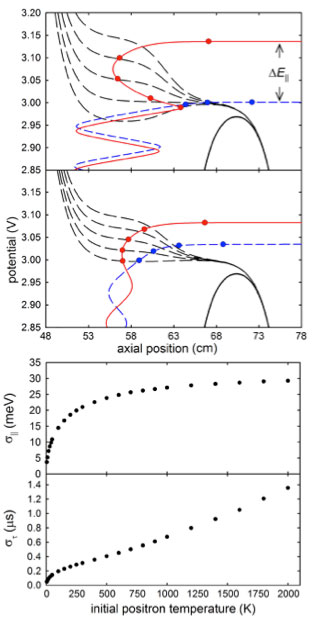
Microbeams from a High-field Trap Centerline Extraction
We have developed a technique to extract a beam of narrow spatial extent from a high-field (5 T) Penning-Malmberg trap. It exploits the fact that the space charge potential is largest at the radial plasma center, and so these particles escape first when an end confining potential is lowered. To use all of the particles and for increased brightness, the plasma is compressed radially using the RW technique
Beams with Gaussian radial profiles and diameters as small as 50 microns have been extracted from electron plasmas with diameters of 2 mm before compression. For small charge extraction (Nb/N0 < <1), a simple theory predicts that the beam half width to 1 e is two debye lengths. the energy distributions of the extracted beams have also been studied in detail, indicating that the beam energy spread is set by, and comparable to, the plasma temperature. the favorable scaling of beam radius with density and temperature [(t n)1/2] indicates that further improvements are possible using colder, higher-density plasmas.
For further reading, see:
"Extraction of Small Diameter Beams from Single-component Plasmas," Danielson et al., Appl. Phys. Lett. 90, 081503 (2007).
"Creation of finely focused particle beams from single-component plasmas," Weber et al., Phys. Plasmas 13, 123502 (2008).
"Energy spectra of tailored particle beams from trapped single-component plasmas," Weber et al., Phys. Plasmas 16, 057105 (2009).
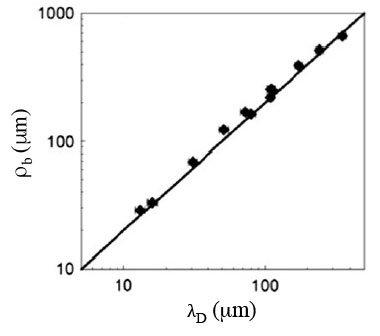
Magnetic Spider Experiments
Certain beam applications call for un-magnetized, “electrostatic” charged particle beams. Unfortunately, low-energy beams extracted from cold lepton plasmas are born in strong magnetic fields. In order to remove such beams from the field, we employ a “magnetic spider” device which is capable of sucking up the magnetic field and simultaneously transmitting the beam.
In order to extract low-energy lepton beams from magnetic fields, we first allow the beam to expand in the flaring field external to the magnet coils, then we pass the beam through the magnetic spider (shown above left) into a field-free region, and finally we focus the beam with a so-called Einzel electrostatic lens. The magnetic spider is made of high-permeability metal which sucks in magnetic field. In the frame of the beam particles passing through the spider, the magnetic field drops quickly to zero, allowing the beam to de-couple from the guiding field lines. The “tines” of the spider typically block around 10% of the incoming beam, although under certain conditions the transmission decreases dramatically (above right), similar to the way venetian blinds block sunlight.
The figures to the right describe focusing of the electrostatic beam in the Einzel lens. The right top figure shows a color map of the electric potential in the lens, as well as a few randomly selected beam particle trajectories (black lines). The lower panel shows focusing performance as a function of lens voltage, for three different values of the magnetic field (20G, 50G, 80G) prior to extraction at the spider. While the 50G and 80G data show reasonable agreement with simulations, the 20G case (leftmost) suffers from the venetian blind beam blocking effect described above.
Further reading:
"Magnetic Field Extraction of Trap-Based Electron Beams Using a High-Permeability Grid" N. C. Hurst, J. R. Danielson, C. M. Surko, Phys. Plasmas 22, 073503 (2015)
